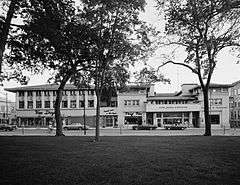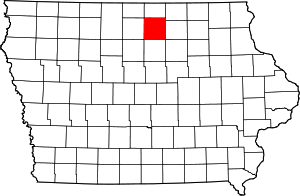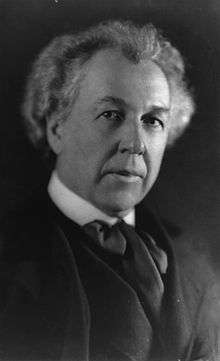Park Inn Hotel
|
Historic Park Inn Hotel | |
|
Front of the Historic Park Inn Hotel (right) and side of the City National Bank Building (left | |
  | |
| Location |
15 W. State St. Mason City, Iowa |
|---|---|
| Coordinates | 43°9′6.44″N 93°12′6.77″W / 43.1517889°N 93.2018806°WCoordinates: 43°9′6.44″N 93°12′6.77″W / 43.1517889°N 93.2018806°W |
| Architect | Frank Lloyd Wright |
| Architectural style | Prairie School |
| NRHP Reference # | 72000470 |
| Added to NRHP | September 14, 1972 |
The Historic Park Inn Hotel and City National Bank are two adjacent commercial buildings located in downtown Mason City, Iowa which were designed in the Prairie School style by the renowned architect Frank Lloyd Wright. Completed in 1910, the Park Inn Hotel is the last remaining Frank Lloyd Wright designed hotel in the world, of the six for which he was the architect of record. The City National Bank is one of only two remaining Frank Lloyd Wright-designed banks in the world. It was the first Frank Lloyd Wright designed project in the state of Iowa, and today carries both major architectural and historical significance. In 1999, the Park Inn Hotel was named on the Iowa Historic Preservation Alliance's Most Endangered Properties List.[1]
Designated an official project of Save America's Treasures by the National Trust for Historic Preservation, the Park Inn Hotel is currently undergoing a complete renovation, including restoration of the distinctive brick and terracotta façade as well as art glass windows that will restore the Prairie School building to a functional boutique hotel by its centennial anniversary in 2010.
The Park Inn Hotel was the third hotel designed by Wright and served as the prototype for Midway Gardens in Chicago and the Imperial Hotel, Tokyo, which was torn down in 1968.[2]
In 1907, when law partners James E. Blythe and J. E. E. Markley were looking for an architect to compete in quality with the eight-story bank building that would be built across the corner, they didn’t hesitate to give the commission to Frank Lloyd Wright, a young architect who was building a reputation in the Chicago area. For them Wright would build a complex, multi-purpose building that would give them multiple income streams. Their law offices would be on the second floor of the building's narrower central waist and the hotel's east wing, surrounded on the south by a two-story banking room with rental office space above. On the north would be a 42-room hotel, with basement shops beneath the Bank and Hotel. Wright managed to pack all these functions into an aesthetically well-integrated building that architecturally would be the bridge between Wright's Prairie School period and his Midway Gardens and the Imperial Hotel to follow.
Construction
Wright’s drawings of the bank and hotel are dated from as early as December 17, 1908. Construction was begun on the first of April 1909, with supervision by Wright until his departure for Europe in late October of that year. At that time William Drummond from Wright’s Oak Park Studio in Oak Park, Illinois took over the supervision of its construction and designed a nearby Prairie style home during his visits. The law office of developer-owners Blythe and Markley was open for business on August 29, 1910, with the gala opening of the entire structure September 10 of that year. Wright returned to the Midwest from his year in Europe in October 1910.
Unfortunately for the Historic Park Inn Hotel, a new 250-room hotel with all the latest amenities was constructed in Mason City in 1922, creating stiff competition for the Park Inn Hotel. In addition, the farm crisis led to the closing of the City National Bank when was merged into another local bank. By 1925, four of the five banks in Mason City had failed. In 1926, the City National Bank building was sold separately and underwent an unsympathetic remodeling into a new commercial use in that year. The upper floors of the Park Inn Hotel were eventually subdivided into rental apartments and over time the unique Prairie School design elements such as stained glass skylights, fixtures, furniture and woodwork were removed or lost. For the next several decades, the Park Inn experienced a gradual decline that ended with its closure in 1972.
Renovation


The Park Inn Hotel received a complete interior and exterior renovation thanks to numerous grants, as well as coordination at the local level. This included a comprehensive restoration of the brick and terra-cotta façade, replacement of the art glass skylight windows, and a complete interior reconstruction.
Wright on the Park, Inc., the organization overseeing the work, purchased the adjacent City Bank Building and reunited the Park Inn Hotel with the City National Bank. The bank building was refitted with an elevator and provides six additional rooms for the hotel; the old bank lobby is now a hotel ballroom.
The restoration was completed in September 2011.[3] It builds on Mason City’s rich architectural heritage, which includes a history deep in Prairie School architecture from not just Wright, but many of his associates who built in Mason City, including Walter Burley Griffin, Marion Mahony Griffin, William Eugene Drummond and Francis Barry Byrne.
Notes
- ↑ The Last Wright, a 2008 documentary film directed by Lucille Carra and produced and written by Carra and Garry McGee, traced the origins of the design of the Park Inn to Wright's first trip to Japan in 1905. The film documented the hotel's history from 1908 through Wright on the Park's ownership in 2008. It won the Grand Prize as best documentary from the Iowa Motion Picture Association in 2008 and received a Regional Midwest Emmy nomination for Best Documentary Writing in 2010. See The Last Wright at the Internet Movie Database.
- ↑ Old Tokyo: Imperial Hotel (1923), Stephen Sundberg
- ↑ Wright on the Park: Hotel History
External links
| Wikimedia Commons has media related to Park Inn (Mason City, Iowa). |
- Wright on the Park, Inc.
- Wright in Iowa
- Reserve a room in The Historic Park Inn Hotel
- The Last Wright on Internet Movie Database





